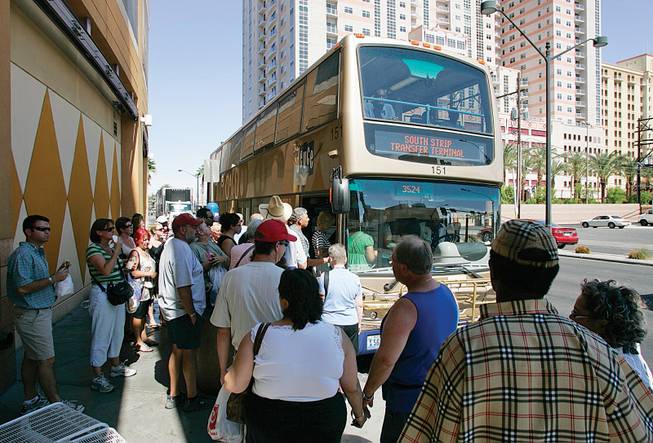
People board a “Deuce” double-decker bus Tuesday on Las Vegas Boulevard at Fremont Street.
Wednesday, Sept. 17, 2008 | 2 a.m.
Sun Archives
- Editorial: Swap cars for buses (6-21-2007)
- Double-deckers to join CAT fleet (4-11-2003)
- Double-decker buses to operate on Strip route (10-1-2002)
Beyond the Sun
An increasing number of Las Vegas Valley residents are getting the chance to ride in the same style as tourists.
The Regional Transportation Commission of Southern Nevada is spreading its popular double-decker buses from the strict province of eye-catching tourist movers to legitimate suburban bus lines, making Las Vegas one of the first cities in the country to look at the high-rise vehicles as a way to move more people for less money.
“Operating costs are less and we tend to actually see a savings of about 25 cents to 33 cents per mile in maintenance costs,” said Mark Wells, the RTC’s assistant general manager for transit. “And they tend to be a little more fuel-efficient.”
They also cost more than other buses in the RTC’s fleet. But the “per-seat” cost is less or equal to the alternatives, Allison Huntly, RTC spokeswoman, said.
Here are the numbers: A 60-foot articulated bus, which is akin to two buses joined accordionlike in the middle, has 55 seats and costs $650,000 — about $11,800 per seat. A standard bus has 36 seats and costs $334,000 — about $9,300 per seat.
The double-decker costs $745,000 but has 81 seats, so that’s about $9,200 per seat.
And riders seem to like them more than the other types of buses, for a variety of reasons.
During a Tuesday afternoon on the route on Boulder Highway, the ride was not only quieter and cooler than on a standard bus, it felt more spacious and comfortable.
“It’s just nice because not every seat is taken,” said one man, taking the double-decker south on Boulder Highway.
And, of course, the view from the top deck makes it a completely different kind of ride.
The buses are 14 feet tall. From up high — the place most riders gravitate to — travelers are treated to less claustrophobic surroundings.
They’ve always been perfect for sightseeing tours, which is why the RTC started using them on the Las Vegas Strip in fall 2005. They proved wildly popular there. On the Strip, “the Deuce” rolls along one of the few, if not only, bus routes in the country that takes in more money than it spends.
From June to October 2006, the RTC tried out a half-dozen double-decker buses on Nellis Boulevard, from Craig Road south to Horizon Ridge Parkway. It was a hit, Wells said.
After spending some time to gear up, the RTC put double-deckers on regular routes beginning in mid-2007.
The four routes that currently use them are on: Sahara Avenue, from Grand Canyon Drive to Hollywood Boulevard; Eastern Avenue, from Gowan Road to Horizon Ridge; Flamingo Road, from Jimmy Durante Boulevard to Grand Canyon Drive; and Boulder Highway, from College Drive to Las Vegas Boulevard.
Of the RTC’s 130 double-deckers, 48 now travel residential routes instead of the Strip.
As an example of their popularity, Huntly pointed to the first attempt at using the buses on Nellis. In just four months, the RTC saw ridership increase 10 percent on that line.
“That was before the big gas price increase and it was really much more than we’ve seen as a whole elsewhere in the system,” she said.
Stephen Walsh is tickled by the popularity of the buses in Southern Nevada. Walsh, vice president of Alexander Dennis Inc., the Scotland-based company that has built double-deckers for 50 years, calls our transportation agency “far and away one of the most innovative in the country.”
“The double-decker occupies the same space as a normal 40-foot bus, and that’s key for the Strip, where it’s very congested,” Walsh said. “It’s better fuel consumption, more space, just better all around.”
Canadian transit agencies also have been buying double-deckers, he said, and Seattle has used a few of them to transport commuters from parking lots to jobs. But lately more interest is coming from other cities, including San Francisco, St. Louis and New York City.
“It’s almost like selling a new religion here,” Walsh said. “The marginal commuters are taking the bus and agencies are finding that it raises the profile, no pun intended, of the agency in the community. People like to see things that are innovative.”
Cities across the country are also calling the RTC to ask about the buses, Wells said. “But we’re still the only one that has them in regular service in the United States.”

Join the Discussion:
Check this out for a full explanation of our conversion to the LiveFyre commenting system and instructions on how to sign up for an account.
Full comments policy